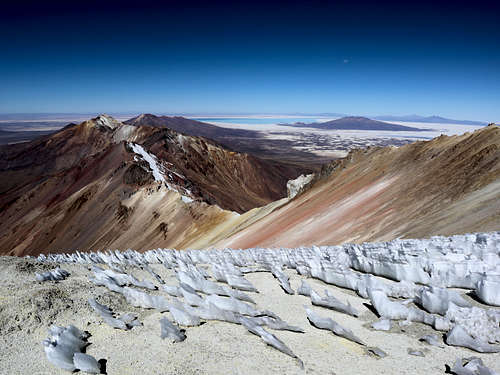|
|
Trip Report |
|---|---|
|
|
19.15643°S / 68.708°W |
|
|
Sep 6, 2022 |
|
|
Mountaineering |
|
|
Winter |
Cerro Cabaray, ascent from La Rivera

The first recorded ascent is attributed to Tobiro Condori before 1980: he reportedly climbed from Chile to the west. By mentioning large Inca structures at the summit, he inspired the archaeologist and climber Johan Reinhard to explore Cabaray, as written in El Enigma de los Santuarios Indígenas de alta Montaña, by Antonio Beorchia. Reinhard climbed Cabaray alone in March 1981, ascending the west ridge (from Chile). At that time, the mountain was snow-covered, and he found no large structures on the top (AAJ 1983).
In September 2022 I planned to ascend Cabaray from the north. I also wanted to solve the mystery of possible Inca structures on the summit. Andres Choque (associated with the Bolivian agency, Climbing South America) was my local guide and climbing partner.
We drove south-southwest from the small village of La Rivera to a plateau at 4,800m just below Cabaray’s north face. This face, which had neither snow nor ice, is bordered by the northeast and north-northwest ridges, with a 50m-high rock barrier just below the summit. On September 6, we set off up the north-northwest ridge, planning to deal with the rock barrier when we got there.
The lower section was an easy scramble and we noticed footsteps in the scree. These ended at around 5,400m, where we found several small sulfur digs. There were also vague vehicle tracks zigzagging up the lower part of the face, probably left by miners.
The terrain became steeper, reaching around 45° as we approached the top. We opted to leave the ridge and traverse left across the face, only to find ourselves sliding with every step. The rainwater and melted snow must have permeated through the scree and then frozen, leaving scree resting on solid ice. We put on crampons, but it was not necessary to use the rope.
We reached the rock barrier, which was loose, white, with protruding sulfur. We crossed the northeast ridge to the east face hoping to find a way to proceed. Fortunately, there was a wide gully, partly filled with icy penitents. By this we reached the summit ridge. The slopes on the far side were snow-covered and we walked easily to the summit. The entire climb had taken five hours.
The view was magnificent. Far away to the north lay snow-covered mountains of the Sajama National Park. To the west Chilean volcanoes were lit by the setting sun. The most colorful view was east to the large blue lake of Salar de Coipasa. The long east ridge of Cabaray led toward other peaks, their colors ranging from yellow to brown to violet due to the presence of mineral oxides. Several rocks on the summit resembled a cairn and beneath them lay a folded piece of paper. Had it been left by Reinhard 41 years ago? No writing was visible. We enlarged the cairn, and I replaced the paper below it.
Nowhere did we see anything that appeared to be a man-made structure. I took pictures and sent them to Reinhard; he was not able to see any Inca structures on these either. However, he believes he did leave a piece of paper below rocks on the summit.

